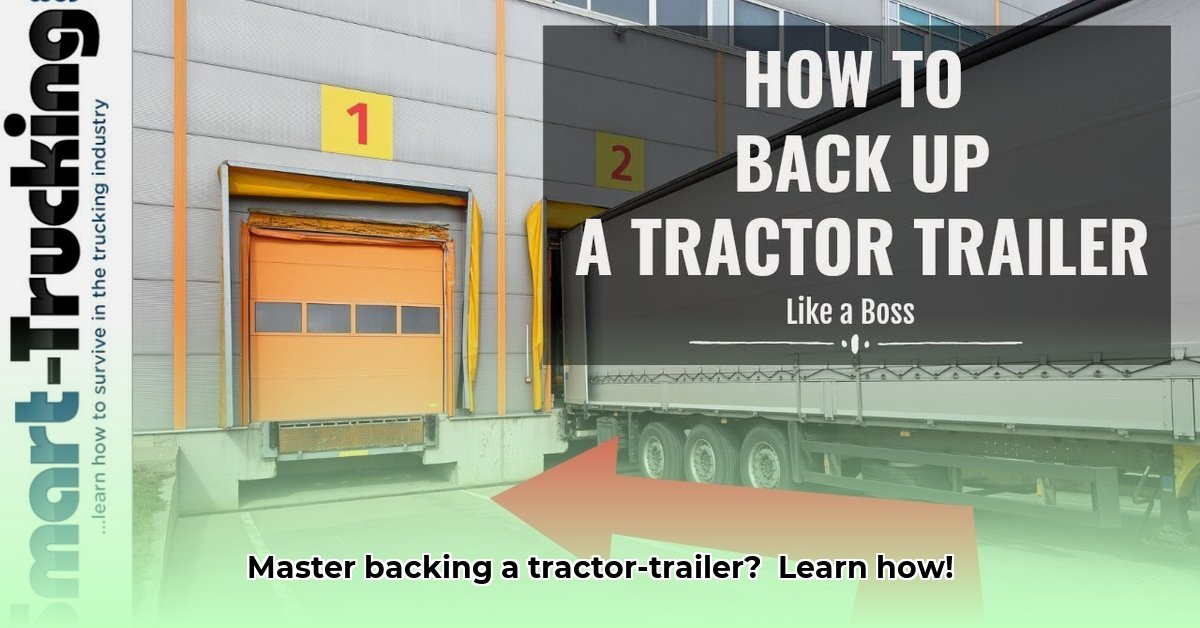
Backing a tractor-trailer can seem daunting, but with the right techniques and practice, it becomes a manageable skill. This guide provides a step-by-step approach, transforming a potentially intimidating task into a confidently executed maneuver. For more in-depth information, check out this comprehensive guide: Semi-Truck Driving Guide.
Pre-Maneuver Preparation: Setting the Stage for Success
Before you even begin, a thorough pre-trip inspection is paramount. This isn't just about ticking boxes; it's about ensuring your safety and the safe operation of your vehicle.
The G.O.A.L. Method: Before you start, utilize the G.O.A.L. method for a comprehensive pre-trip check:
- Gas: Check your fuel level. Low fuel can impact weight distribution and handling.
- Oil: Verify oil and other fluid levels are within acceptable ranges.
- Air: Ensure adequate air pressure in your braking system.
- Lights: Confirm all your lights and signals are functioning correctly.
Assessing the Backing Area: Carefully evaluate your backing area, visualizing your entire maneuver. Consider:
- Space: Is there sufficient space for the entire trailer’s swing radius (the arc the trailer makes when backing)? Insufficient space significantly increases the risk of collisions.
- Obstacles: Identify any potential obstructions like parked vehicles, poles, low-hanging branches, or uneven terrain.
- Traffic: Ensure the area is clear of pedestrians and moving vehicles. Plan for potential traffic flow disruptions while maneuvering.
- Route: Mentally plan your path, identifying reference points that will guide your movement.
Failing to properly assess your backing area can lead to costly accidents and damage. A few minutes of careful planning can save you countless hours of trouble.
Steering Techniques: Mastering the Art of Precision
Two main steering techniques exist: the visual method and the combination method.
1. The Visual Method: Choose a target point (e.g., a corner of the parking space). Focus on that point and make very slight steering wheel adjustments. Your mirrors are vital for verifying the trailer's position. Your movements should be extremely gradual and controlled.
2. The Combination Method: Utilize a combination of your mirrors and a feel for the truck's movement. Begin by using your mirrors to roughly align your path, then use smaller steering corrections based on the feel of the trailer's response. This method requires more experience.
Regardless of your chosen technique: Remember that slow and steady movements are crucial. Jerky movements are highly dangerous and should be avoided at all costs.
Mirror Utilization: Your Additional Eyes
Your mirrors are invaluable tools; don't simply glance, but actively scan your surroundings using all three mirrors (left, right, and convex). They provide a 360-degree view, critical for safe backing in tight spaces. Continuous monitoring prevents collisions and allows for timely corrections. "Constant scanning of your mirrors is the key to safe backing," advises Captain Robert Miller, a veteran driver trainer at Safe Trucking Academy.
Safety Precautions: Prioritizing Safety
Safety is paramount. Always:
- Maintain low speed: Creep along slowly, focusing on precise control. Sudden stops or jerky movements can lead to jackknifing (the trailer forming an acute angle with the tractor).
- Signal properly: Use your turn signals generously to indicate your intentions to other drivers and pedestrians.
- Honk your horn: Alert others to your presence, especially when visibility is limited around bends or corners.
- Observe continuously: Stay aware of your surroundings – pedestrians, other vehicles, and potential hazards.
- Assess Risks: Before every maneuver, anticipate potential risks, including collisions, property damage, and personal injury. This risk assessment, however brief, will greatly improve your safety and situational awareness.
Practice and Refinement: Honing Your Skills
Consistent practice is crucial to mastering tractor-trailer backing.
- Find a safe practice area: An empty, large parking lot is ideal.
- Start simple: Begin with straightforward reverse maneuvers before progressing to more complex scenarios.
- Gradual progression: Challenge yourself gradually, mastering tighter spaces and more difficult angles as your skills improve. "Practice is the only way to internalize these techniques," says Sarah Chen, PhD, a transportation safety expert from MIT. "It will make the difference between a safe maneuver and a dangerous one."
Remember, it takes time and patience.
Advanced Techniques (Optional): Beyond the Basics
Once proficient in basic backing, you can explore advanced techniques such as backing into tight docks, navigating sharp corners, or handling challenging inclines. However, advanced maneuvers should be attempted on a controlled setting with a knowledgeable supervisor until true proficiency is reached.
Troubleshooting: Addressing Common Issues
- Jackknifing: If your trailer forms a sharp angle with the tractor, slow down immediately and gently steer to straighten it.
- Obstacles: If you encounter an unexpected obstacle, stop immediately, reassess your situation, and proceed cautiously.
- Limited Visibility: Utilize spotters to gain better awareness of your surroundings, especially in low-visibility situations.
Conclusion: The Ongoing Journey of Mastery
Backing a tractor-trailer is a skill honed through consistent practice and a commitment to safety. By following these guidelines and dedicating time to practice, you can develop the proficiency and confidence needed for safe and efficient maneuvering. Remember, ongoing practice is key to continuous improvement.